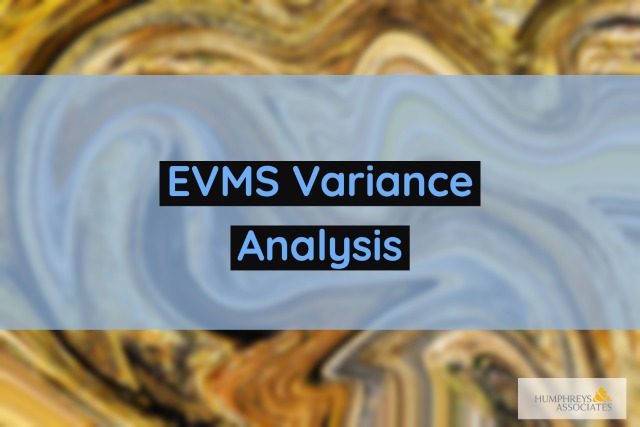
A Variance Analysis Report (VAR) that includes specific information about the cause, impact, and corrective action “provides management with early insight into the extent of problems and allows corrective actions to be implemented in time to affect the future course of the program” [reference: NDIA, IPMD EIA-748 (Revision D) EVMS Intent Guide]. Unfortunately, variance analysis is an easy target for criticism during EVMS reviews. There are many examples of inadequate variance analysis to choose from, but what they all have in common is the lack of specific information on the “why, what, how, when, and who” of any variance. The variance analysis reporting requirements are found in the EIA-748 (Revision D) Guidelines in Section IV., Analysis and Management Reports, Guidelines 22-27.
| EIA-748 Guidelines Section IV. Analysis and Management Reports |
||
|---|---|---|
| 22 | 2-4a | Control Account Monthly Summary, Identification of CV and SV |
| 23* | 2-4b | Explain Significant Variances | Earned Value Management |
| 24 | 2-4c | Identify and Explain Indirect Cost Variances |
| 25 | 2-4d | Summarize Data Elements and Variances thru WBS/OBS for Management |
| 26* | 2-4e | Implement Management Actions as Result of EVM Analysis |
| 27* | 2-4f | Revise EAC Based on Performance Data; Calculate VAC |
A VAR that includes specific information and data about a problem will allow management to make informed decisions and mitigate project risk. Getting specific about variance analysis reporting includes the following elements.
Overall:
- Emphasis on the quantitative, not qualitative
- Emphasis on the specific, not the general
- Emphasis on significant problems, not all problems
- Define abbreviations and acronyms at first use
- The Control Account Manager (CAM) is the most knowledgeable person to write the variance analysis report but will need information from the business support team
Cause:
- Isolate significant variances
- Discuss cost and schedule variances separately
- Clearly identify the reason (root cause) for the variance (ties to the corrective action plan)
- Clear, concise explanation of the technical reason for the variance
- Provide cost element analysis
- Labor – hours, direct rates, skill mix, overtime (rate & volume)
- Material – unplanned requirements, excess quantities, unfavorable prices (price & usage)
- Subcontracts – changing requirements, additional in-scope work, schedule changes
- Other Direct Costs – unanticipated usage, in-house vendor
- Overhead (indirect) – direct base, rate changes
- Identify what tasks are behind schedule and why
Impact:
- Describe specific cost, schedule, and technical impact on the project
- Project future control account performance (continuing problem)
- Address effect on immediate tasks, intermediate schedules, critical path, driving paths, risk mitigation tasks
- Describe erosion of schedule margin, impacts to contractual milestones or delivery dates, and when the schedule variance will become zero (this may only mean the work getting completed late (BCWPcum =BCWScum); and does not necessarily mean getting “back on schedule”
- Describe any impact to other control accounts
- Assess the need to revise and provide rationale for the Estimate at Completion (justify ETC realism – CPI to TCPI comparison, impacts of corrective action plan, risk mitigation, open commitments, staffing changes, etc.)
- Note: If there is a root cause, there will be an impact. It could be related to cost, schedule, lessons learned to be applied to future activity, an update required to a process to support the corrective action or a re-prioritization of resources to meet a schedule.
Corrective Action Planning:
- Describe specific actions being taken, or to be taken, to alleviate or minimize the impact of the problem
- Include the individual or organization responsible for the required action
- Include schedules for the actions and estimated completion dates (ECD)
- If no corrective action is possible, explain why
- Include results of corrective action plans in previous VARs.
Ask yourself, is the analyses presented in a manner that is understandable? Does the data support the narrative? Does the variance explanation provide specifics of:
“why” the problem occurred,
“what” is impacted now or in the future,
“how” the corrective action is being taken,
“when” the corrective actions will occur,
“when” the schedule variance will become zero, and/ or the work gets “back on schedule”
“who” is responsible for implementing the corrections?
Remember, a well-developed Variance Analysis Report can reduce the risk of a Corrective Action Request (CAR) during an EVMS review.

Pingback: Variance Analysis, Corrective Action Plans, Root Cause Analysis - Humphreys & Associates
Pingback: Budgeting for Rework | SRR & EVM | Earned Value Management
Pingback: Tips for Implementing Effective Earned Value Training
Pingback: EVM Contract Performance - Schedule Variance - Humphreys & Associates
Pingback: EVM Contract Performance - Cost Variance
Pingback: Determining Responsibility for Indirect Cost Variance Analysis - Part 1 - Humphreys & Associates
Pingback: Contract Performance - Variance Thresholds
Pingback: Management Reserve Best Practice Tips - Humphreys & Associates